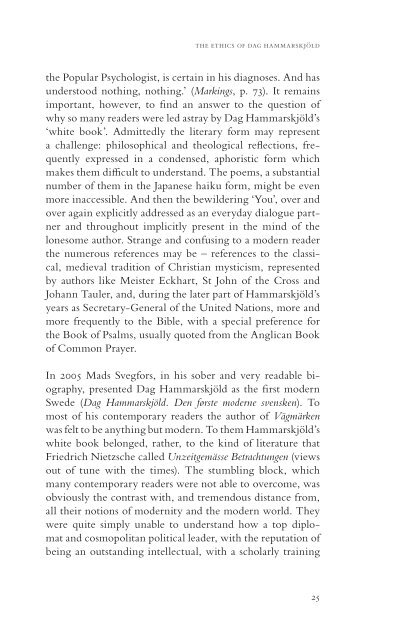Download as pdf - Dag Hammarskjöld Foundation
Download as pdf - Dag Hammarskjöld Foundation
Download as pdf - Dag Hammarskjöld Foundation
Create successful ePaper yourself
Turn your PDF publications into a flip-book with our unique Google optimized e-Paper software.
the ethics of dag hammarskjöld<br />
the Popular Psychologist, is certain in his diagnoses. And h<strong>as</strong><br />
understood nothing, nothing.’ (Markings, p. 73). It remains<br />
important, however, to find an answer to the question of<br />
why so many readers were led <strong>as</strong>tray by <strong>Dag</strong> <strong>Hammarskjöld</strong>’s<br />
‘white book’. Admittedly the literary form may represent<br />
a challenge: philosophical and theological reflections, frequently<br />
expressed in a condensed, aphoristic form which<br />
makes them difficult to understand. The poems, a substantial<br />
number of them in the Japanese haiku form, might be even<br />
more inaccessible. And then the bewildering ‘You’, over and<br />
over again explicitly addressed <strong>as</strong> an everyday dialogue partner<br />
and throughout implicitly present in the mind of the<br />
lonesome author. Strange and confusing to a modern reader<br />
the numerous references may be – references to the cl<strong>as</strong>sical,<br />
medieval tradition of Christian mysticism, represented<br />
by authors like Meister Eckhart, St John of the Cross and<br />
Johann Tauler, and, during the later part of <strong>Hammarskjöld</strong>’s<br />
years <strong>as</strong> Secretary-General of the United Nations, more and<br />
more frequently to the Bible, with a special preference for<br />
the Book of Psalms, usually quoted from the Anglican Book<br />
of Common Prayer.<br />
In 2005 Mads Svegfors, in his sober and very readable biography,<br />
presented <strong>Dag</strong> <strong>Hammarskjöld</strong> <strong>as</strong> the first modern<br />
Swede (<strong>Dag</strong> <strong>Hammarskjöld</strong>. Den første moderne svensken). To<br />
most of his contemporary readers the author of Vägmärken<br />
w<strong>as</strong> felt to be anything but modern. To them <strong>Hammarskjöld</strong>’s<br />
white book belonged, rather, to the kind of literature that<br />
Friedrich Nietzsche called Unzeitgemässe Betrachtungen (views<br />
out of tune with the times). The stumbling block, which<br />
many contemporary readers were not able to overcome, w<strong>as</strong><br />
obviously the contr<strong>as</strong>t with, and tremendous distance from,<br />
all their notions of modernity and the modern world. They<br />
were quite simply unable to understand how a top diplomat<br />
and cosmopolitan political leader, with the reputation of<br />
being an outstanding intellectual, with a scholarly training<br />
25
















